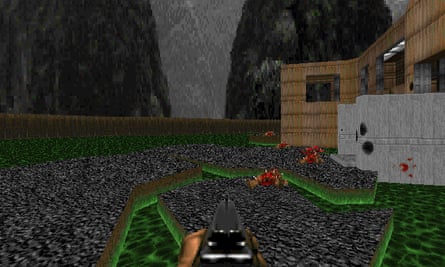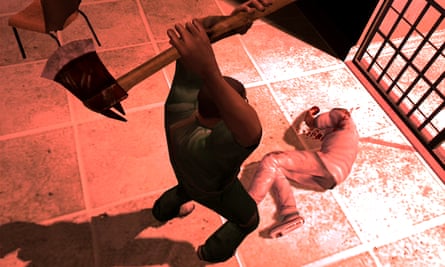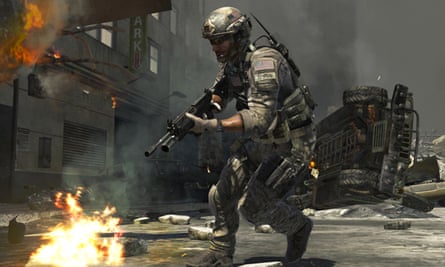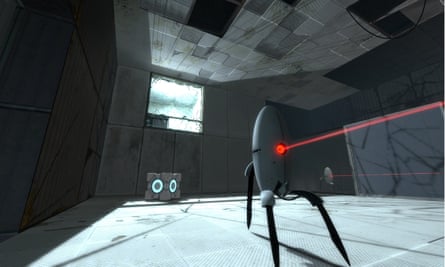In 1976, the driving simulation Death Race was removed from an Illinois amusement park. There had, according to a news story at the time, been complaints that it encouraged players to run over pedestrians to score points. Through a series of subsequent newspaper reports, the US National Safety Council labelled the game “gross” and motoring groups demanded its removal from distribution. The first moral panic over video game violence had begun.
This January, a group of four scholars published a paper analysing the links between playing violent video games at a young age and aggressive behaviour in later life. The titles mentioned in the report are around 15-years-old – one of several troubling ambiguities to be found in the research. Nevertheless, the quality and quantity of the data make this an uncommonly valuable study. Given that game violence remains a favoured bogeyman for politicians, press and pressure groups, it should be shocking that such a robust study of the phenomenon is rare. But it is, and it’s important to ask why.
A history of violence
With the arrival of Pong in 1973, video games became a commercial reality, but now, in 2016, they are still on the rocky path to mass acceptance that all new media must traverse. The truth is that the big targets of moral concern – Doom, Grand Theft Auto, Call of Duty – are undeniably about killing and they are undeniably popular among male teenagers. An industry report estimates that 80% of the audience for the Call of Duty series is male, and 21% is aged 10-14. Going by the 18 rating on the last three entries, that means at least a fifth of the game’s vast audience shouldn’t be playing.
The problem is, while regulatory boards like Pegi in Europe and ESRB in the US are doing what they can to inform people about age certification, you have products like Mega Bloks, one of Mattel’s major toy lines, featuring Call of Duty branded playsets. The question of video games and violence remains controversial because of relationships like this. Consumers, parents, the games industry itself, regulatory bodies, and the headline-hungry media – all contribute towards an era in which moral, sociocultural and developmental concerns are pitted against commercial interest.

Over the past three decades, there have been plenty of headlines about games research, but on many occasions the studies are flawed, limited or misleading, or are simply misrepresented – often, it has to be said, by their own accompanying press releases.
‘Violent videogames cause an increase in aggression long after the game has been turned off’ is the headline for one 2010 study, which draws this conclusion by linking a 20-minute gaming session with an abstract aggression test 24 hours later, and differentiating between players who had ‘thought’ about the game in the interim and those who hadn’t. This is a tenuous experimental setup in the first place and one that fails to account for any number of other factors, so to draw firm causal conclusions – never mind extrapolate (as the authors did at the time) that it is “reasonable to assume that our lab results will generalise to the ‘real world’” – is fanciful.
The problem is not just on academia’s side: the media almost never stops to challenge a tasty headline linking games and real-world violence. This use of games as panic fodder is not benign, but percolates into real-world flash points that have consequences. Rockstar North, the pioneering Scottish development studio behind the Grand Theft Auto series, also made Manhunt – a 2003 stealth-horror title that features brutal killing animations. Manhunt was erroneously implicated in a 2004 murder case by the tabloids, with MP and chair of home affairs committee Keith Vaz telling the House of Commons: “The parents of the victim believe that the perpetrator of this savage attack was influenced by the videogame Manhunt.”

The police reported that a copy of the game was found in a bedroom – but it was later discovered that the game was actually owned by the victim, Stefan Pakeerah, and the crime’s motive was instead “drug-related robbery.” At trial the defence, prosecution, and eventually the judge all agreed that the game was not a factor. But by this point Manhunt had already been banned by several large retailers and the link was fixed in the public mind to the point where facts didn’t matter – the Daily Mail reported the eventual sentencing as “Teenager gets life for ‘Manhunt murder.’” Before the evidence had emerged the paper had campaigned for the game to be banned.
When a sequel to the game was announced three years later, the response was predictable. Dogged by controversy, Manhunt 2 was subsequently refused classification by the BBFC – not once, but twice. It eventually limped out, heavily-censored, on appeal and years late. Manhunt 2 is a graphically violent game, but it’s unexceptional when put next to the Saw films – and is intended for adults. It is difficult to believe that the BBFC’s decision was based on the content of the game, rather than a response to media pressure. This is an extreme example but it shows how inaccurate actions can arise from inaccurate reporting, anecdote, and unwarranted inference.
The state of the art
It’s in this context that January’s research paper is exceptional. Entitled ‘Prospective Investigation of Video Game Use in Children and Subsequent Conduct Disorder and Depression Using Data from the Avon Longitudinal Study of Parents and Children’ it was co-authored by Dr Peter Etchells of Bath Spa University, Dr Suzanne Gage and Professor Marcus Munafò of the University of Bristol, and Dr Adam Rutherford.
“I think it started off as frustration really at all the stuff you see in the news,” says Etchells. “Either studies that are overhyped or people making claims that aren’t backed-up by evidence. Suzanne Gage was using this Children of the 90s dataset and we thought ‘why don’t we have a look in this dataset to see if there’s anything we could use to look at this question.’ We didn’t have any funding, it’s something we had to do in our spare time.”
The Children of the 90s is a group of around 14,500 children born in the Avon area between 1991-1992 and observed for the Avon Longitudinal Study of Parents and Children [Alspac]. This size makes it a prime research tool, but the combination of clinical data and video game data gives it an unusual value: conduct disorder is a real-world measure of aggression, not an abstract clinical test; the video games played are differentiated by genre. This doesn’t mean the dataset lacks problems, such as how useful genre classifications really are, but it’s a solid foundation.
The Conduct Disorder study looks at whether children at the age of eight or nine are playing video games, what genres they’re playing, and then, using statistical controls, looks at a specific measure of aggression at age 15 to see if there is any association between the two. Conduct disorder is a bunch of related negative behaviours in children and adolescents, which here is measured in six levels – from (1) extremely unlikely you have it to (6) very likely.
“This is a context-finding study rather than a causal study, so we’re not saying ‘you play violent videogames, you get more aggressive,’” says Etchells. “With that, what our main finding shows is that if you take these different games people have played when they’re eight- or nine-years-old, and try and account for as many potential confounding variables as possible that might have an effect on aggression, socioeconomic status and stuff like that, at age 15 there is a 19% higher chance of being in one of those higher conduct disorder bands, as you go from not playing games to playing puzzle games to playing shoot-em-up games.”
“Then if we take the violent/non-violent division, which I don’t really like calling that, if you play shoot-em-up games there’s a 19% risk of you being higher up in one of those conduct bands than if you didn’t play violent games. So that doesn’t mean you’re going to be diagnosed with conduct disorder, it’s just that you’re maybe more likely to show those aggressive tendencies.”
Lies and damned lies
Here we come to the difficult job of interpreting statistics, because a bald 19% may seem to indicate quite a sizeable increase – but that number represents a correlation rather than a causal factor, spread over six levels, for a disorder that you have a tiny risk of being diagnosed with in the first place (of 1,815 children in the sample, 26 met the criteria.) On top of this there are the external factors (‘confounders’) which the study accounts for, and the ones it doesn’t – the known unknowns and the unknown unknowns.
“It’s not ‘if you play videogames that will cause you to have higher risk of being in a higher conduct disorder band,’” says Etchells. “That’s just one part. If you look at the p-values [which gauge the uncertainty around the data] they’re quite high at over 0.5 – so the strength of that association seems to be quite weak. It suggests there are other things that are having an effect that are driving that association.”

What the Conduct Disorder study is saying is that there’s a relationship here worth looking into, but it can’t point the finger at anything, and that above all the association is weak. This conclusion has to be interpreted in the context of (a) the solid data and (b) other studies arguing for a much larger and in some cases causal effect between violent videogames and aggressive behaviour. The fact these findings are so uncertain also highlights the difficulties researchers face in getting a handle on the subject.
The problem with violent video games and aggression is that defining and categorising both is an inexact science. The Children of the 90s study began in 1991, so the ‘shoot-em-ups’ this paper was looking at when those kids were eight or nine might be the likes of Goldeneye 007, Medal of Honor, Quake III and so on. These games are from a different and often incomparable era to the modern first-person shooter, a Call of Duty or Halo, which is much more realistic visually and in most cases includes a competitive online element.
The sharp-eyed will have spotted that ‘shoot-em-up’ is itself something of a misnomer, more commonly used to refer to 2D space blasters than 3D first-person shooting games. Such a distinction might seem rather fine, and many conflate the two, but it really matters. “In the questionnaires they asked essentially what kind of games do you play, and categorised them by genre,” says Etchells. “Now the options aren’t great, and it’s a point that came up in review: shoot-em-up is a different category to FPS. So there are assumptions in what we’ve done, in the sense that if you’re playing Goldeneye you’re probably going to tick the ‘shoot-em-up’ box, even if that might not be the exact genre.”
This seems a not-unreasonable assumption, though it shows how even such good data can have a troubling fuzziness up-close. But this is a broader issue for games research. “We don’t have a good way of categorising games,” says Etchells. “I don’t think genres is a particularly good way of doing it. Technically Portal 2 would be in our shoot-em-up category here, but that’s not an especially violent or competitive game. You could make an argument that certain platform games are violent, even say Mario in the sense of squashing goombas.”

To briefly unpack that, Portal 2 could be fairly described as a puzzle game – but one played from a first-person perspective. Your character has a ‘gun,’ but it fires portals onto walls rather than bullets, and is used to navigate the environments. Minor elements of the game, such as the automated turrets in some levels, mean you could argue for Portal 2 to be categorised as a first-person shooter, but the content bears so little relation to a game like Call of Duty it shows how essentially meaningless the definition is.
When you look at videogames research, it’s difficult to escape the suspicion that many of these studies don’t understand the different aspects and modes in a game like Call of Duty – and much more importantly, how players interact with them. Call of Duty has a single-player mode, several co-operative modes, and an online competitive mode, each of which you play with a different mindset.
“We didn’t look at context massively in our study, but how you play videogames will likely have an effect on what their effect on you is,” says Etchells. “So it also might be different playing a particular mode solo to playing it with loads of people in the room with you, and if those people are mates or your parents or siblings.”
The Conduct Disorder study draws a distinction between competitive games and violent games, but most contemporary games defy such easy categorisation while many of the biggest hits have elements of both. What of last year’s breakout hit Rocket League, which is ultra-competitive but has no violence? Some games are designed to be lifestyle commitments over months and years, like the online shooter Destiny or any given massively multiplayer role-playing game, while others last minutes. Genres are an inadequate way of categorising the nature of these experiences, and thus measuring their potential impact.
“There have been 25 years of research in this area and, for the most part, it’s not very good research,” says Etchells. “Particularly the experimental side. It’s a real missed opportunity, because there’s so much stuff about this in the media and we really don’t have a handle on it, and it would be good to have a handle on it so we could maybe get a final say at some point – either no, games are not an issue or, look, games are an issue but in these populations in these situations and it’s these games specifically. We can’t say anything even close to that at the minute.”
The funding gap
It’s worth remembering that part of the problem is the reluctance of funding bodies to support researchers in this area – it’s surprising to say the least that a study of this importance had to be undertaken by the researchers in their spare time. What video games research needs is more high-quality work in the field, because the questions are not impossible to answer. “The dataset we used is open and available,” says Etchells. “What I’d like to see happen in this area is people doing more open science, making their data available to other researchers. Just so we can start getting it right! Because there’s so much stuff that’s not right out there.”
The violence debate also holds us back from other, possibly more interesting, questions about this omnipresent interactive entertainment medium. There is an enormously positive side to games that receives no attention, yet the potential fruits of research could be enormous. “Take brain training games and whether they work,” says Etchells. “The evidence there is quite shaky, some suggests they do work and a lot says they don’t, but if there were anything there that would be novel and quite important. That’s a more useful question to ask really.”
Without quality research, we allow debates about videogames to be influenced by ideologically-driven sceptics. It is less than a decade since one of Britain’s greatest developers, Rockstar North, had to censor Manhunt 2. Perhaps we’ll look back on that the same way we look at something like A Clockwork Orange, in 1972, being blamed for various violent acts – the whipped-up reaction to which saw Stanley Kubrick request the film be withdrawn from British distribution.
Film is not the same as videogames, of course. But Kubrick’s response to the charge that A Clockwork Orange was inspiring copycat violence is, in the absence of answers, an important one to consider. “To try and fasten any responsibility on art as the cause of life seems to me to put the case the wrong way around,” he said. “Art consists of reshaping life, but it does not create life, nor cause life. Furthermore, to attribute powerful suggestive qualities to a film is at odds with the scientifically accepted view that, even after deep hypnosis in a posthypnotic state, people cannot be made to do things which are at odds with their natures.”
Do videogames make your kids violent? No one knows and, by now, we really should have a better answer than that.

Comments (…)
Sign in or create your Guardian account to join the discussion